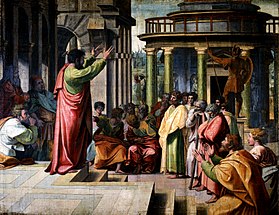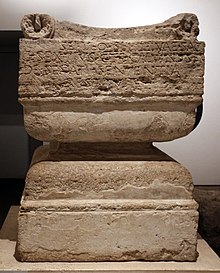Unknown God
The Unknown God or Agnostos Theos (Ancient Greek: Ἄγνωστος Θεός) is a theory by Eduard Norden first published in 1913 that proposes, based on the Christian Apostle Paul's Areopagus speech in Acts 17:23, that in addition to the twelve main gods and the innumerable lesser deities, ancient Greeks worshipped a deity they called "Agnostos Theos"; that is: "Unknown God", which Norden called "Un-Greek".
[4] According to the book of Acts, contained in the Christian New Testament, when the Apostle Paul visited Athens, he saw an altar with an inscription dedicated to that god (possibly connected to the Cylonian affair),[5] and, when invited to speak to the Athenian elite at the Areopagus, gave the following speech: 22Paul stood in the middle of the Areopagus, and said, "You men of Athens, I perceive that you are very religious in all things.
29Being then the offspring of God, we ought not to think that the Divine Nature is like gold, or silver, or stone, engraved by art and design of man.
But now he commands that all people everywhere should repent, 31because he has appointed a day in which he will judge the world in righteousness by the man whom he has ordained; of which he has given assurance to all men, in that he has raised him from the dead.
For Plotinus, the first principle of reality is "the One", an utterly simple, ineffable, unknowable subsistence which is both the creative source of the Universe[10] and the teleological end of all existing things.

